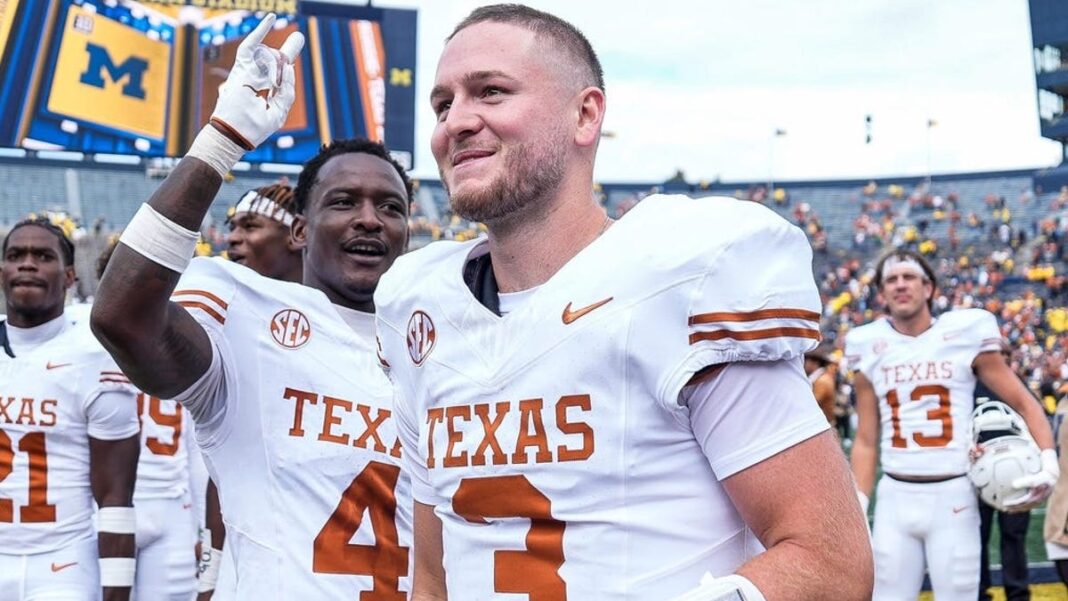Opinion: The Reality of Quarterback Transfers: The Urgency to Succeed in Big-Money College Football
Let’s keep this straightforward. Check out the latest US LBM Coaches Poll.
The top three teams in the poll—Texas, Ohio State, and Oregon—are all utilizing quarterbacks who transferred in.
Out of the top 10 teams, five have starting quarterbacks who came through the transfer portal, and 11 of the top 25 teams are in the same boat. Additionally, two teams that made it to last year’s College Football Playoff featured transfer quarterbacks.
If you need further proof, consider this: After Georgia’s national championship win in 2021 with quarterback Stetson Bennett, Coach Kirby Smart almost secured All-American quarterback Caleb Williams from the transfer portal.
This happened even though Bennett still had one more year of eligibility and went on to win another national title in 2022.
“We’re always working to enhance our team,” Smart stated.
That is the politically correct stance, but the topic ignites a deeper discussion within college football.
Should programs focus on recruiting and developing young quarterbacks, or should they aim for instant results through the transfer portal?
A coach from a major conference shared with YSL News Sports, “There’s less uncertainty with transfers. When you recruit a high school quarterback, every situation is fresh, and you can’t predict how they’ll handle weekly challenges. On the other hand, you could bring in someone from the portal who has game footage, has experienced wins and losses, and is already emotionally equipped. It’s an easy choice.”
This coach chose to remain anonymous due to the sensitive nature of this discussion.
From high-caliber teams to those in the process of rebuilding, the transfer portal offers the simplest solution for filling the vital quarterback position.
Per analysis by Paul Myerberg from YSL News Sports, since the advent of NIL and the transfer portal in the 2021 season, 77 different quarterbacks have transferred into a Power Four program and started for at least one year.
This year alone, 41 out of 68 possible starting quarterback positions in Power Four conferences, which accounts for 60.3 percent, are filled by transfers.
These statistics are remarkable and reveal a significant trend.
“Each coach has a unique approach to achieving victories,” stated Arkansas coach Sam Pittman, who kicked off a crucial 2024 season with Taylen Green from Boise State. “But the quarterback position has changed dramatically. It’s taken on a life of its own.”
A significant element of this new trend is that the quarterback’s role within the game has become paramount, with a shift toward a more aggressive passing game applying pressure on coaching staff to find the right candidates.
There’s no room for leniency or gradual onboarding for quarterbacks; they must adapt quickly.
With an influx of money from billion-dollar media rights agreements, funding flows into various aspects of college football, including revenue sharing with players and skyrocketing coaching contracts. This has created a scenario where it’s critical to make every decision count. It’s financially reckless to hand a multimillion-dollar program to most 18-year-old freshman quarterbacks.
Teams and coaches can’t afford a wrong call when it comes to recruiting and nurturing high school quarterbacks, as the risks often outweigh the benefits. Players have recognized this pattern and adjusted accordingly.
If top-tier quarterbacks don’t start during their freshman year, they often transfer, drawing interest from other programs. At the very least, they bring a year of college experience with them, both in life and on the field. It’s a perplexing situation, as described by the late Bobby Bowden.
While there are still elite quarterbacks with the capabilities and determination to start right away, they are becoming increasingly rare. Of the last four quarterbacks ranked No.1 in high school by the 247Sports composite rankings, only DJ Lagway from Florida started a game in his debut season.
Lagway’s first start came in Week 2 this season due to starter Graham Mertz’s concussion protocol. In contrast, Quinn Ewers (Ohio State, 2021), Drew Allar (Penn State, 2022), and Arch Manning (Texas, 2023) all did not start their freshman year.
These three are projected first-round NFL draft picks who didn’t get playing time until their second college season. Ewers’ situation particularly illustrates this ongoing cycle.
He was the top overall recruit in 2021 and one of only two players to receive a perfect score from 247Sports evaluators. He did not play during his first season at Ohio State, unable to surpass CJ Stroud and backup Kyle McCord in the depth chart.
Before sustaining a core injury in September, Ewers was a frontrunner for the Heisman Trophy. He has now returned, leading the Longhorns toward the CFP and potentially further, before stepping into the NFL and continuing another emerging trend.
Four of the six quarterbacks selected in the first round of the 2024 NFL draft were transfers, including the top two overall choices (Williams and Jayden Daniels).
“Every play is crucial and can be the deciding factor between victory and defeat,” noted the Power Four coach.
“Are you genuinely going to blame someone who was just playing high school football not even a year ago?”
That’s definitely not a politically correct stance.

